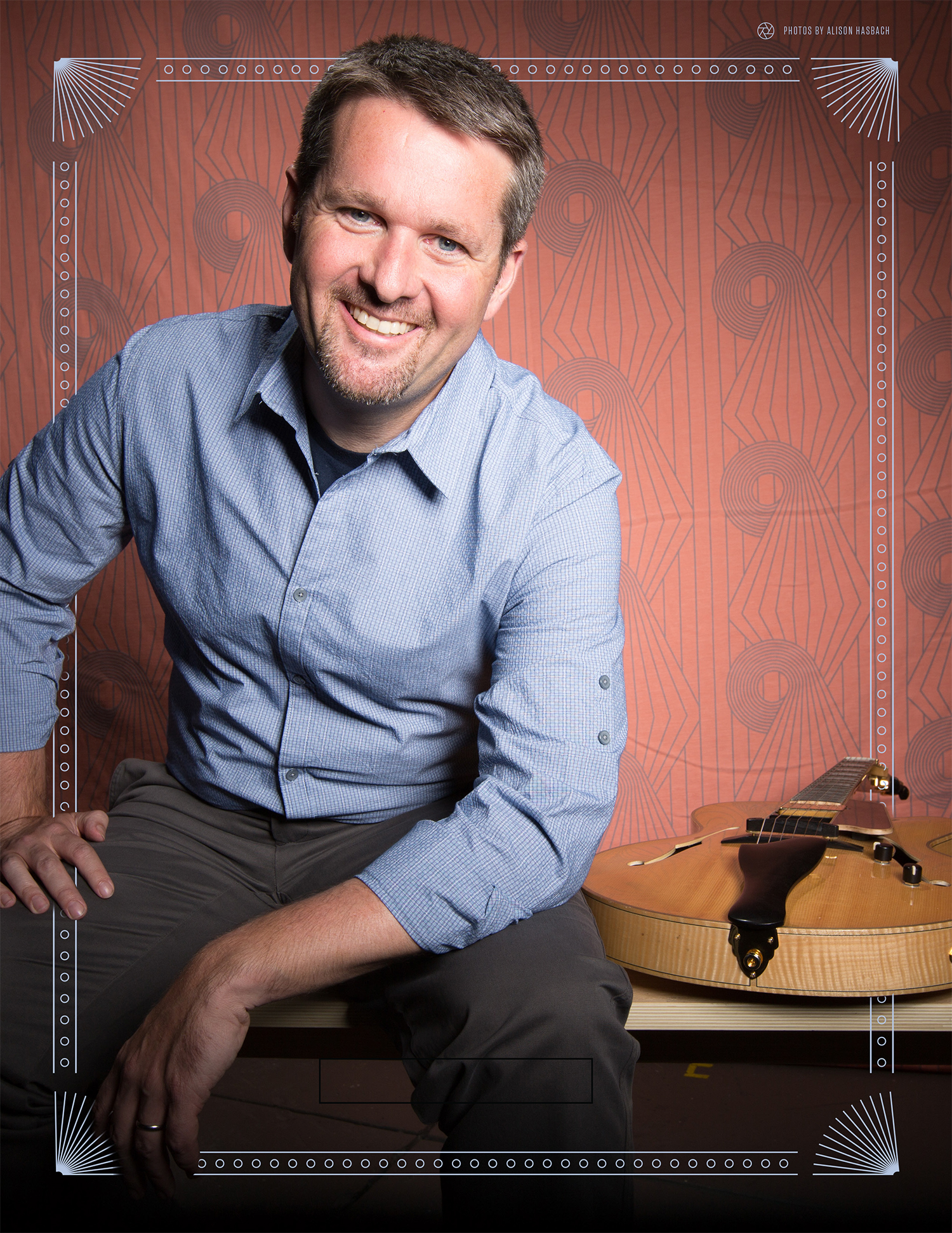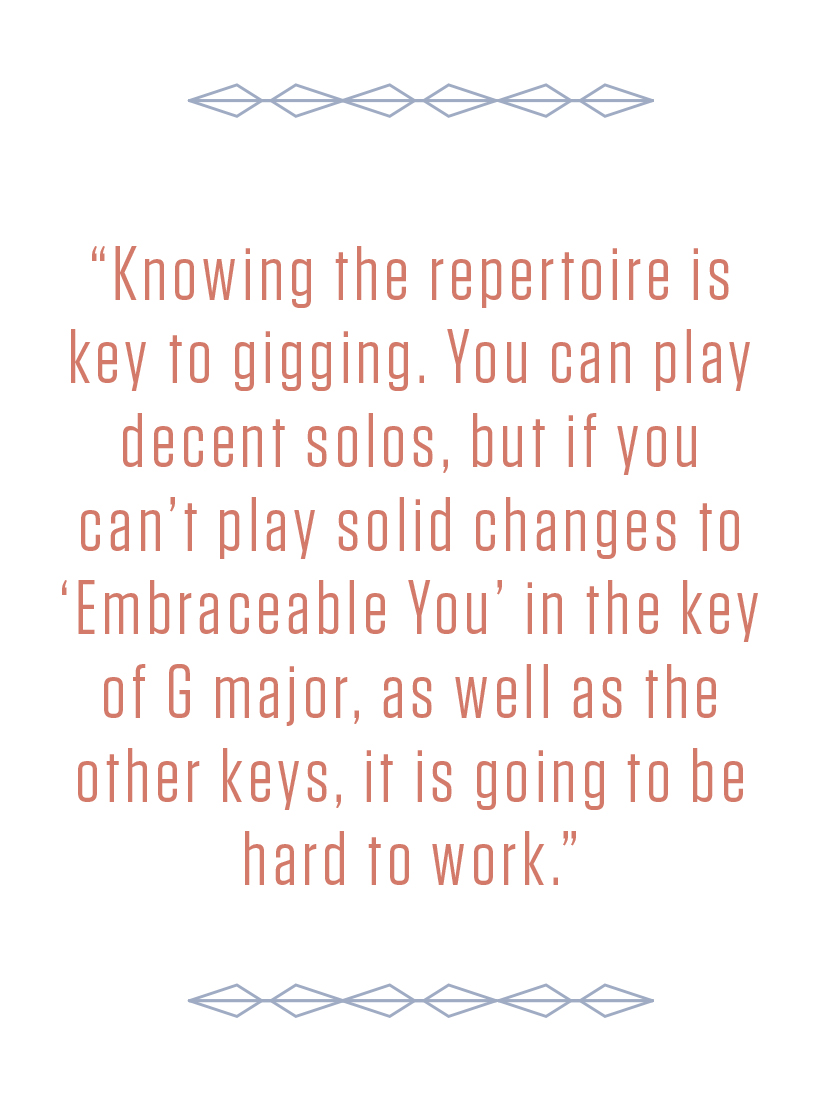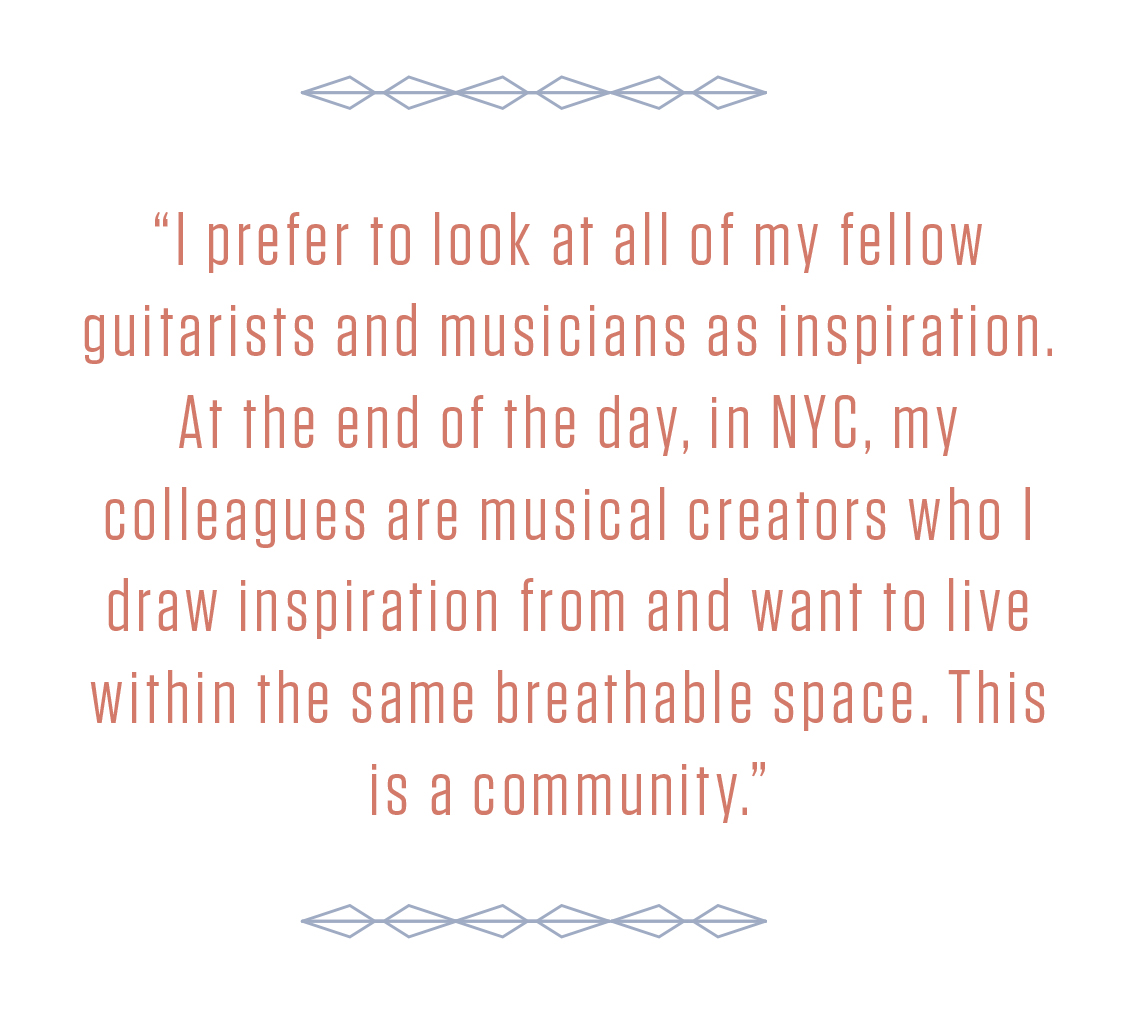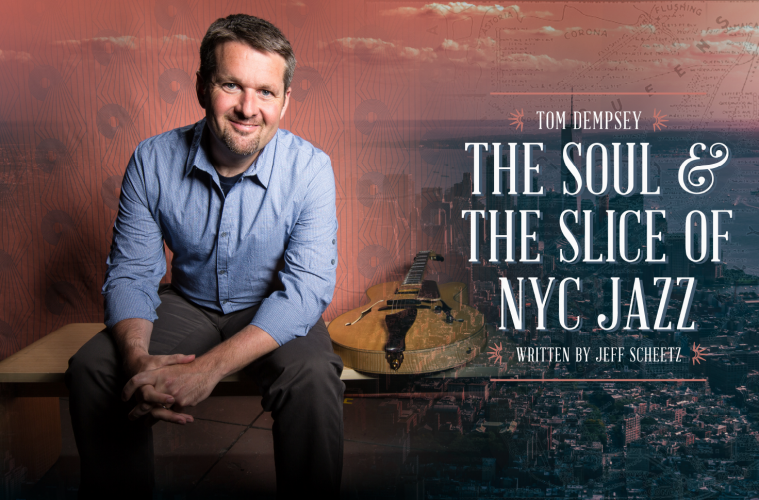 hen you think of NYC Jazz, you think of gritty, yet polished – cutting edge, yet steeped in tradition.
hen you think of NYC Jazz, you think of gritty, yet polished – cutting edge, yet steeped in tradition.
If you were a rock musician in the 80’s you might have set your sights on playing the Roxy Theater or the Whiskey a Go-Go in Los Angeles. Likewise NYC has a long list of legendary venues whose names are whispered with reverence by wide-eyed young jazz musicians as soon as they learn their first diminished 7th arpeggio. Names like the Blue Note, Iridium, Birdland or the Village Vanguard are the Holy Grail for jazz musicians seeking to be a part of a real jazz scene.
Tom Dempsey is an in-demand player and teacher living the jazz life in NYC. I talked with him about what that’s like, how he got here and what kind of advice he could share with anyone wanting their own slice of the Big Apple jazz pie.
Tom keeps busy with all kinds of gigs and says, “The gigs I play are all over the map: solo, duo, trio, quartet and beyond. And sometimes it is not even a jazz setting per se. Tonight I played at the Big Apple Circus at Lincoln Center (a totally different kind of gig). It can be as low as gigging three times a week, but it can be as high as gigging 7 nights a week with multiple gigs on some of those nights.”
That is a lot of playing time! But you don’t just start at the top. I asked Tom about his early days.
“I was 8 years old when I first started playing guitar. As a kid I remember always being fascinated by the instrument. We would go to my grandmother’s house and she would have ‘Hee Haw’ on the television. I just loved the music…Buck Owens, Roy Clark, and all the musicians. There was also this priest at the church we went to who would play the guitar at mass. His name was Father Mike Bassano. A priest playing guitar at church was a good hook to get me to go to mass!”
 “Hee Haw” isn’t usually the first thing you associate with inspired improv in a dimly lit Jazz club, but sometimes it just takes a spark to start a fire. Tom says, “I began playing folk music…singer songwriter stuff. I even sang a little. Then I got into rock and blues. That led me to jazz.”
“Hee Haw” isn’t usually the first thing you associate with inspired improv in a dimly lit Jazz club, but sometimes it just takes a spark to start a fire. Tom says, “I began playing folk music…singer songwriter stuff. I even sang a little. Then I got into rock and blues. That led me to jazz.”
Tom’s path from early guitar excitement to pro jazzer could be a whole book in itself. Suffice it to say Tom believes he’s had a lot of help and inspiration along the way: whether it’s been from motivating teachers to peer musicians that pushed Tom to grow as a player. He was also inspired when, “In my high school band room in 1984, I discovered a poster for a new program called the National Guitar Summer Workshop. One of the guest artists that would be attending was Larry Coryell. I had several records by him that I had borrowed from the public library, but I thought, to be there in person would be incredible. At the time I had a paper route, so I saved all my money and attended the one week that he was going to be there. That same week included faculty from the metropolitan New York area that also changed my life.”
Tom loved his time at the NGW so much that he found himself returning as part of the faculty.
“From that first year until the program closed in 2012, I remained involved teaching and being the Director of Music. At NGW I was able to play with so many of my guitar heroes including Jim Hall, Pat Metheny, John Scofield, John Abercrombie, Tal Farlow, Bucky Pizzarelli, and many others.”
 Tom’s love of teaching and his desire to share his knowledge has led to his gig as Associate Professor of Music at LaGuardia Community College. His in-depth and well-organized instructional courses have made him a student favorite at TrueFire.
Tom’s love of teaching and his desire to share his knowledge has led to his gig as Associate Professor of Music at LaGuardia Community College. His in-depth and well-organized instructional courses have made him a student favorite at TrueFire.
Often the idea of jumping into a jazz gig can be intimidating for young players. Tom says the key is being prepared for anything. “Sometimes I get to rehearse with the band. Most times not. Sometimes you have to do your own research and preparation ahead of the gig. Sometimes you are playing standards. Sometimes you are at the mercy of the leader calling those standards. Sometimes you are reading original music all night long for the first time. That’s where having all of your skills together is so important. Being broad and complete in your approach is very important.”
Other tips on putting yourself in a good place to get the call? “Knowing the repertoire is key to gigging. You can play decent solos, but if you can’t play solid changes to ‘Embraceable You’ in the key of G major, as well as the other keys, it is going to be hard to work.” While it seems that the competition among players would be stiff, Tom winces at that notion. “Competition. Not a big fan of this term when it comes to dealing with playing music and living in a creative space. I can see how it would be easy for some to look at your fellow guitarists as competition. I prefer to look at all of my fellow guitarists and musicians as inspiration. At the end of the day, in NYC, my colleagues are musical creators who I draw inspiration from and want to live within the same breathable space. This is a community.”
While it seems that the competition among players would be stiff, Tom winces at that notion. “Competition. Not a big fan of this term when it comes to dealing with playing music and living in a creative space. I can see how it would be easy for some to look at your fellow guitarists as competition. I prefer to look at all of my fellow guitarists and musicians as inspiration. At the end of the day, in NYC, my colleagues are musical creators who I draw inspiration from and want to live within the same breathable space. This is a community.”
 Good advice. When asked about the steps for a young player, Tom offers, “My initial reaction is that any jazz musician should spend some time living and playing in New York City. Having traveled a significant amount throughout the world, I feel that the soul of the music lives in NYC. However, there are great musicians living all throughout the world. If you see a scene there, become a part of that scene. Hang out in the clubs. Play. Be known by your presence and your playing. Present yourself professionally. When you go to a club look like you are coming from a gig with your instrument in hand. Don’t look like you rolled out of bed. Professional appearances lead to professional work. Hang and be known. Don’t sit in your apartment posting videos and strategizing your next social media campaign.”
Good advice. When asked about the steps for a young player, Tom offers, “My initial reaction is that any jazz musician should spend some time living and playing in New York City. Having traveled a significant amount throughout the world, I feel that the soul of the music lives in NYC. However, there are great musicians living all throughout the world. If you see a scene there, become a part of that scene. Hang out in the clubs. Play. Be known by your presence and your playing. Present yourself professionally. When you go to a club look like you are coming from a gig with your instrument in hand. Don’t look like you rolled out of bed. Professional appearances lead to professional work. Hang and be known. Don’t sit in your apartment posting videos and strategizing your next social media campaign.”
That professional attitude has led to Tom performing or recording with some of the most renowned jazz musicians in the world. He has toured the world playing jazz and in 2012 performed on behalf of the US State Department as a Music Ambassador throughout the country of Tunisia.
The next year has Tom recording, teaching and keeping the music alive. His plans are focused and clear, “My resolve is to serve the music. I want to serve it in a way that allows for my musical voice to speak. I feel that we need to be part of the solution to how we create the opportunity to expand our audience, create new opportunities through our work, and educate the future musicians to carry on the integrity of the music.” With this point of view it is a sure bet that Tom will continue to have a presence in the jazz scene of NYC and beyond.


